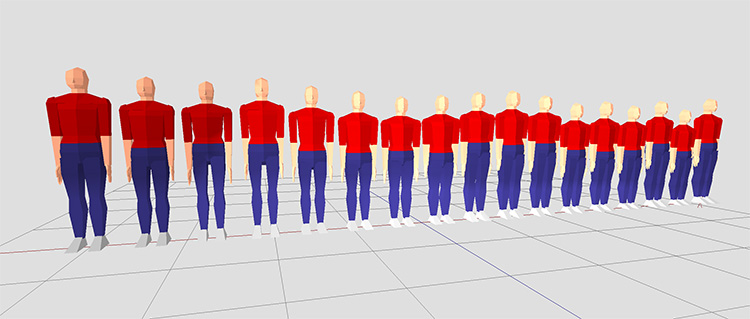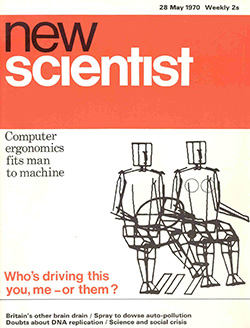Anthropometry
Appropriate use of SAMMIE ensures that people can be comfortably accommodated by the design being evaluated. The layout of public areas, factories, offices and homes can also be assessed to optimise space, ease of movement of people, and safety. One of the most important capabilities of a DHM tool is to be able to size the human model to represent an appropriate range of users from the intended user population. SAMMIE allows the dimensions of the human models to be varied to represent differences in Nationality and gender. Allowances can be made for clothing, and personal equipment can be modelled and suitably positioned on the human model.
Human models in SAMMIE can be sized in a number of ways. For traditional univariate, percentile driven models (e.g. 5th or 95th %ile), humans can be created to represent males or females from the following National population data included with the SAMMIE system: UK, US, Chinese, Dutch, French, German, Italian, Japanese and Swedish. These data are sourced from DTI ADULTDATA (1998), in addition there are also a number of DEF-STAN data sets available for military populations.

The A-CADRE manikin family, consisting of 17 human models from the American male popualtion in this case.
Individual components of the human model can also be interactively set to any percentile or absolute value using internal (bone length) or external (standard measured) data. Using external measured data more representative multivariate, non-proportional, human models can be created from any data source. SAMMIE can create a human model from eight standard measures: stature, sitting height, sitting shoulder height, buttock knee length, knee height, arm length (acromion to fingertip), hand length, and shoulder breadth (biacromion). This supports the use of other data sets (e.g. ANSUR, NHANES) or the collection of data from real people relevant to the analysis being performed (truck drivers, assembly workers, etc.)
In addition to body size, body shape can also be modified to represent variations in corpulence or muscularity. SAMMIE employs the somatotyping systems developed by Sheldon (1940). Three metrics of Endomorphy (fatness), Ectomorphy (thinness) and Mesomorpy (muscularty) can be varied to create 72 levels of body shape.
This flexibility enables the designer to create realistic 'worst case' models which are not always simply the extreme short and thin or tall and fat individuals. For example, the driver's arm reach in a car is a function of leg length as this has a large influence upon seat position. If a short driver with short arms and legs and a tall driver with long arms and legs are used to depict worst case scenario models the analysis will not highlight the need expressed by the majority of drivers to have an adjustable steering wheel. This is because the driver with short arms will have adjusted the seat fully forwards so that his or her short legs can reach the pedals. But what if this driver had longer legs, as is often the case? What if the tall driver had shorter legs? SAMMIE supports this type of multivariate accommodation analysis.
When using SAMMIE we also recommend the use of some sort of approach that optimises the exploration of human variability. There are a number of multivariate manikin approaches, one we have found useful in project work is the A-CADRE approach as developed by Bitner (2000). This allows a set of 17 human models to be created that are capable of representing a 400 member random sample of humans. SAMMIE's eight core external measures are compatible with those required by A-CADRE and so the human models are easily produced for the desired population. This non-proportional model family can be combined with traditional extremes to provide a comprehensive analysis of any situation.






